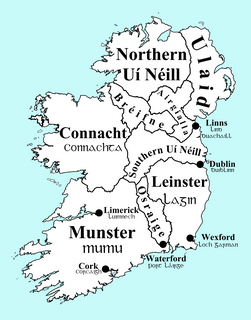Congal Cáech was a king of the Cruthin of Dál nAraidi in the medieval Irish province of Ulaid, from around 626 to 637. He was king of Ulaid from 627–637 and, according to some sources, High King of Ireland.
Fiachnae mac Demmáin was King of Ulaid from 626 to 627. Sometimes called Fiachnae Dubtuinne. He was a member of the Dal Fiatach and nephew of Baetan mac Cairill of Ulaid. He was the son of Demmán mac Cairell. He succeeded his uncle as king of the Dal Fiatach in 581.
Blathmac mac Máele Cobo was a Dál Fiatach ruler of the over-kingdom of Ulaid. He was the son of Máel Cobo mac Fiachnai. He ruled from 647 to 670.
Congal Cennfota mac Dúnchada was a Dal Fiatach king of Ulaid. He was the son of Dúnchad mac Fiachnai, a previous king. He ruled from 670 to 674. His nickname Cennfota means "Long-headed".
Fergnae mac Óengusso Ibdaig was a Dal Fiatach king of Ulaid. He was the nephew of Muiredach Muinderg mac Forgo and grandson of Forga mac Dallán, previous kings.
Áed Róin mac Bécce Bairrche was the Dál Fiatach ruler of the over-kingdom of Ulaid in Ireland. He reigned from 708 to 735. He was the son of Bécc Bairrche mac Blathmaic,, a previous king of Ulaid who had abdicated in 707 to become a pilgrim.
Eochaid mac Condlai was a king of Ulaid from the Dal nAraide. He was the son of Condlae mac Cóelbad, also a king of Dal nAraide and grandson of the high king and King of Ulster Cáelbad mac Crond Ba Druí. He belonged to the main ruling dynasty of the Dal nAraide known as the Uí Chóelbad based in Mag Line, east of Antrim town in modern county Antrim.
Events from the 7th century in Ireland.
Dúnchad mac Fiachnai was King of Ulaid from the Dal Fiatach dynasty. He was the son of Fiachnae mac Demmáin, a previous king. He ruled from 637 – c.644.
Cathassach mac Lurgain was a Dal nAraide king of the Cruithne in Ulaid (Ulster). He was the son of Fiachnae mac Báetáin a king of all Ulaid and possible high king and brother of Eochaid Iarlaithe mac Lurgain, a King of the Dal nAraide. He ruled from 666 to 668.
Fiachnae mac Áedo Róin was a Dál Fiatach ruler of the over-kingdom of Ulaid in Ireland. He reigned from 750 to 789. He was the son of Áed Róin and brother of Bressal mac Áedo Róin, previous kings. This family had their base in modern-day County Down, Northern Ireland.
Tommaltach mac Indrechtaig was a King of Dal nAraide in Ulaid (Ulster) and possible King of all Ulaid. He was the son of Indrechtach mac Lethlobair, a previous King of Dal nAraide. He ruled from 776 to 790 and as King of all Ulaid from 789 to 790. He belonged to the main ruling dynasty of the Dal nAraide known as the Uí Chóelbad based in Mag Line, east of Antrim town in modern county Antrim.
Eochaid mac Fiachnai was a Dal Fiatach king of Ulaid, which is now Ulster, Ireland. He was the son of Fiachnae mac Áedo Róin, a previous king. He ruled from 790 to 810.
Máel Bressail mac Ailello was a king of Ulaid, which is now Ulster, Ireland. He belonged to a branch of the Dal nAraide known as the Uí Echach Cobo in the west part of county Down. He ruled as King of Ulaid from 819-825.
Lethlobar mac Loingsig was a Dál nAraidi king of Ulaid, in medieval Ireland. He was the grandson of Tommaltach mac Indrechtaig, a previous king of Ulaid. He belonged to the main ruling dynasty of the Dál nAraidi known as the Uí Chóelbad based in Magh Line. He ruled as king of the Dál nAraidi from 824/849-873 and as leth-ri (co-king) of Ulaid from 857-871 and sole king of Ulaid from 871-873.
Aitíth mac Laigni was a King of Ulaid, which is now Ulster, Ireland. He belonged to a branch of the Dal nAraide known as the Uí Echach Cobo in the west part of county Down. He ruled as King of Ulaid from 896-98.



